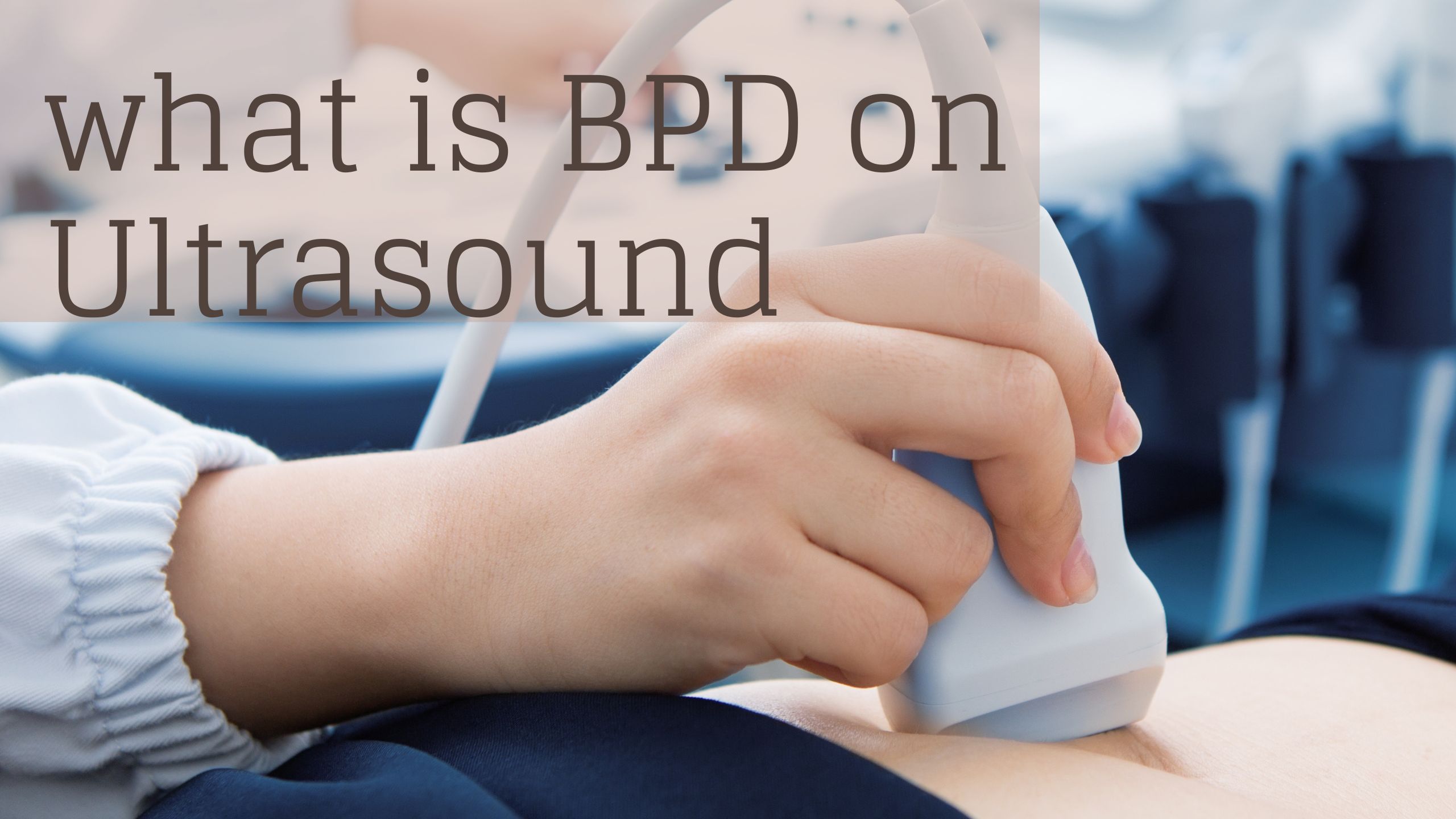“What is BPD on Ultrasound?” is a common question asked by expectant parents seeking to understand the significance of this measurement during prenatal scans.
“BPD” stands for “Biparietal Diameter” in the context of medical ultrasonography imaging. A prenatal ultrasound examination of a growing fetus involves measuring the biparietal diameter.
It is one of many prenatal biometric measurements used to determine the gestational age and gauge the fetus’s growth and development.
The distance between the two parietal bones of the fetal skull is known as the biparietal diameter. These two large, flat bones make up the skull’s sides and roof. When discussing “BPD on Ultrasound,” it’s essential to emphasize that this measurement provides valuable insights into the developing fetus’s health and well-being.
Healthcare professionals can determine the fetal gestational age and track fetal growth by measuring the biparietal diameter. When pregnant, it is especially helpful in the second trimester.
One of the various measurements made during prenatal ultrasound procedures is the biparietal diameter (BPD). It is a measurement of the distance between the parietal bones in the developing baby’s skull.
Biparietal diameter is used to determine the gestational age and fetal weight.
Each parietal bone in a person is located on the left and right sides of the skull, respectively. Each parietal bone has two surfaces and four sides, and it resembles a curved plate.
Imagine holding a string in your hands, putting one end above your right ear and the other above your left, and letting the string lay on top of your head. You could estimate your biparietal diameter very roughly based on the length of the thread.
This measurement is performed by an ultrasound professional while they are utilizing digital measuring equipment and viewing your developing baby on a computer screen.
How BPD Is Measured and When?
Typically, BPD measurements are taken during routine prenatal ultrasounds. Most people get one to three sonograms, also known as ultrasounds, typically during the first trimester of pregnancy through the twentieth week. High-risk individuals might require more ultrasound exams.
Along with the following three measurements, a BPD measurement is helpful:
- size of the head
- circumference of the abdomen
- The femur is the thigh bone and is the longest bone in the body.
Together, those three measurements can be used to calculate the gestational age (or how far along the pregnancy is), as well as the fetal weight.
The BPD measurement also provides you and your doctor with information about the brain development of your unborn child. Your doctor wants all of the measurements, including the BPD measurement, to fall within the acceptable range.
At 13 weeks, the biparietal diameter measurement is around 2.4 centimeters; at term, it is approximately 9.5 centimeters.
Late in pregnancy, a biparietal diameter measurement is not thought to be as accurate in estimating gestational age.2 BPD typically has a 10–11 day margin of error for determining gestational age between weeks 12 and 26 of pregnancy.
However, it can be wrong by as much as three weeks beyond week 26 of pregnancy.3 According to other studies, after week 20 BPD accuracy decreases.
When BPD Is Abnormally Extensive
Your doctor could suggest additional testing if the results for your baby fall outside of the typical range. For example, if your baby’s BPD measurements are smaller than typical, this may indicate that your uterus is preventing your baby from growing or that your baby has a flatter head than usual.
When a baby’s BPD reading is higher than normal, it may indicate a health problem, like gestational diabetes.
A low BPD might suggest keeping an eye on the fetal head’s development.4 For mothers who may have been exposed to the Zika virus, microcephaly can be a cause for concern.
The skull is deemed to be extremely flat and microcephaly is suspected if the BPD is two standard deviations below the mean. Other signs of microcephaly include the way the head looks and various dimensions.
Women with a confirmed or suspected Zika virus infection are advised to have fetal ultrasounds every three to four weeks, according to the Centers for Disease Control and Prevention (CDC).5
From EnglishwithMumin, a Word
When you receive ultrasound results that are abnormal, it might be unsettling. However, there may be a variety of causes for this to happen on a single ultrasound, including the fetus’s location, movement during the scan, and the technician’s expertise.
A fuller understanding of your baby’s health may be provided by additional ultrasounds and other tests.
What is BPD on ultrasound normal range?
The normal range for Biparietal Diameter (BPD) on ultrasound can vary slightly depending on the gestational age of the fetus. However, as a general guideline, here are approximate normal BPD values for different gestational ages:
At around 12 weeks of gestation, the BPD is typically between 2.4 and 3.0 centimeters.
At approximately 20 weeks of gestation, the BPD typically ranges from 4.0 to 5.6 centimeters.
Beyond 20 weeks, the BPD continues to increase gradually with gestational age.
What is BPD on ultrasound in cm?
On an ultrasound, the biparietal diameter (BPD) is commonly measured in centimeters (cm). The diameter of the fetal skull between the two parietal bones is represented by this measurement. During prenatal ultrasounds, it is a crucial measure used to gauge fetal development and calculate gestational age. Healthcare professionals use the BPD measurement, which is frequently stated in centimeters, to track the growth and well-being of the fetus during pregnancy.
What is BPD on ultrasound 32 weeks?
The Biparietal Diameter (BPD) on ultrasound normally ranges from 8.4 to 9.7 centimeters (cm) at 32 weeks of gestation. It’s crucial to remember that these numbers can somewhat change between people and populations. To gauge gestational age and evaluate fetal growth and development, ultrasound measurements—including BPD—are employed.
What is BPD on ultrasound 20 weeks?
The Biparietal Diameter (BPD) on ultrasonography is normally between 4.0 and 5.6 centimeters (cm) at 20 weeks of gestation. This measurement is done to determine the fetus’ gestational age and to evaluate its growth and development. But be aware that people and populations can differ slightly in these values.
What is bpd in pregnancy?
During pregnancy, BPD stands for “Biparietal Diameter.” Using ultrasound imaging, the biparietal diameter can be measured in order to gauge the fetus’s growth and development and determine its gestational age. Between the two parietal bones, which are the flat, broad bones that make up the sides and roof of the skull, it shows the size of the fetal head.
What is normal bpd in pregnancy?
The normal Biparietal Diameter (BPD) in pregnancy can vary slightly depending on the gestational age of the fetus. Here are approximate normal BPD values for different stages of pregnancy:
At around 12 weeks of gestation, the BPD is typically between 2.4 and 3.0 centimeters (cm).
At approximately 20 weeks of gestation (the midpoint of a typical 40-week pregnancy), the BPD typically ranges from 4.0 to 5.6 cm.
As the pregnancy progresses beyond 20 weeks, the BPD continues to increase gradually with gestational age.



